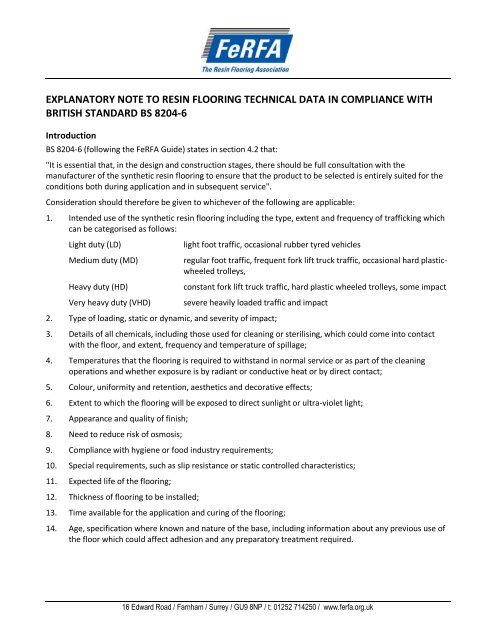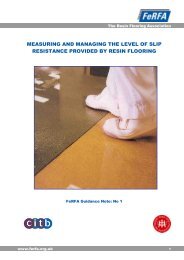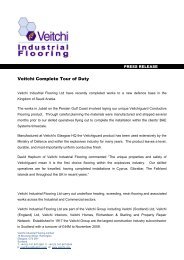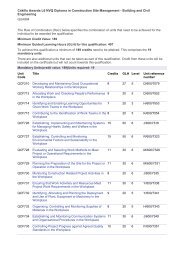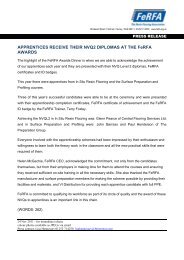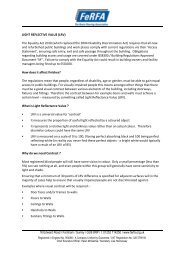Explanatory note to Resin Flooring Technical Data in ... - FeRFA
Explanatory note to Resin Flooring Technical Data in ... - FeRFA
Explanatory note to Resin Flooring Technical Data in ... - FeRFA
You also want an ePaper? Increase the reach of your titles
YUMPU automatically turns print PDFs into web optimized ePapers that Google loves.
EXPLANATORY NOTE TO RESIN FLOORING TECHNICAL DATA IN COMPLIANCE WITH<br />
BRITISH STANDARD BS 8204-6<br />
Introduction<br />
BS 8204-6 (follow<strong>in</strong>g the <strong>FeRFA</strong> Guide) states <strong>in</strong> section 4.2 that:<br />
"It is essential that, <strong>in</strong> the design and construction stages, there should be full consultation with the<br />
manufacturer of the synthetic res<strong>in</strong> floor<strong>in</strong>g <strong>to</strong> ensure that the product <strong>to</strong> be selected is entirely suited for the<br />
conditions both dur<strong>in</strong>g application and <strong>in</strong> subsequent service".<br />
Consideration should therefore be given <strong>to</strong> whichever of the follow<strong>in</strong>g are applicable:<br />
1. Intended use of the synthetic res<strong>in</strong> floor<strong>in</strong>g <strong>in</strong>clud<strong>in</strong>g the type, extent and frequency of traffick<strong>in</strong>g which<br />
can be categorised as follows:<br />
Light duty (LD) light foot traffic, occasional rubber tyred vehicles<br />
Medium duty (MD) regular foot traffic, frequent fork lift truck traffic, occasional hard plasticwheeled<br />
trolleys,<br />
Heavy duty (HD) constant fork lift truck traffic, hard plastic wheeled trolleys, some impact<br />
Very heavy duty (VHD) severe heavily loaded traffic and impact<br />
2. Type of load<strong>in</strong>g, static or dynamic, and severity of impact;<br />
3. Details of all chemicals, <strong>in</strong>clud<strong>in</strong>g those used for clean<strong>in</strong>g or sterilis<strong>in</strong>g, which could come <strong>in</strong><strong>to</strong> contact<br />
with the floor, and extent, frequency and temperature of spillage;<br />
4. Temperatures that the floor<strong>in</strong>g is required <strong>to</strong> withstand <strong>in</strong> normal service or as part of the clean<strong>in</strong>g<br />
operations and whether exposure is by radiant or conductive heat or by direct contact;<br />
5. Colour, uniformity and retention, aesthetics and decorative effects;<br />
6. Extent <strong>to</strong> which the floor<strong>in</strong>g will be exposed <strong>to</strong> direct sunlight or ultra-violet light;<br />
7. Appearance and quality of f<strong>in</strong>ish;<br />
8. Need <strong>to</strong> reduce risk of osmosis;<br />
9. Compliance with hygiene or food <strong>in</strong>dustry requirements;<br />
10. Special requirements, such as slip resistance or static controlled characteristics;<br />
11. Expected life of the floor<strong>in</strong>g;<br />
12. Thickness of floor<strong>in</strong>g <strong>to</strong> be <strong>in</strong>stalled;<br />
13. Time available for the application and cur<strong>in</strong>g of the floor<strong>in</strong>g;<br />
14. Age, specification where known and nature of the base, <strong>in</strong>clud<strong>in</strong>g <strong>in</strong>formation about any previous use of<br />
the floor which could affect adhesion and any prepara<strong>to</strong>ry treatment required.<br />
16 Edward Road / Farnham / Surrey / GU9 8NP / t: 01252 714250 / www.ferfa.org.uk
A His<strong>to</strong>ry of <strong>Res<strong>in</strong></strong> <strong>Floor<strong>in</strong>g</strong> <strong>Technical</strong> <strong>Data</strong><br />
Synthetic <strong>Res<strong>in</strong></strong> <strong>Floor<strong>in</strong>g</strong> started life as concrete repair compounds and were <strong>in</strong>itially manufactured by<br />
companies who supplied products and additives <strong>to</strong> the concrete <strong>in</strong>dustry. The result has been that his<strong>to</strong>rically<br />
most manufactures quoted technical data such as compressive, tensile, flexural strength etc. Although pure<br />
physical test results serve <strong>to</strong> give a comparison with concrete it is clear that those same physical properties<br />
cannot be directly correlated <strong>to</strong> the performance of a res<strong>in</strong> floor<strong>in</strong>g system. In fact <strong>in</strong> some cases such as<br />
compressive strength, a very high value could produce a brittle res<strong>in</strong> which had little ability <strong>to</strong> withstand<br />
impact or thermal movement.<br />
Synthetic <strong>Res<strong>in</strong></strong> <strong>Floor<strong>in</strong>g</strong> is applied directly <strong>to</strong> a concrete substrate <strong>in</strong> thickness between a 100 microns and 25<br />
mm whereas concrete test<strong>in</strong>g is carried out us<strong>in</strong>g large cast blocks or beams. Synthetic <strong>Res<strong>in</strong></strong> <strong>Floor<strong>in</strong>g</strong> absorbs<br />
<strong>in</strong><strong>to</strong> the substrate surface produc<strong>in</strong>g a chemical bond with<strong>in</strong> the surface of the concrete and as such it is<br />
impracticable <strong>to</strong> test for physical strength properties by the same methods used <strong>in</strong> concrete test<strong>in</strong>g.<br />
In the early days of the development of synthetic res<strong>in</strong> floor<strong>in</strong>g concrete test methods were used <strong>to</strong> determ<strong>in</strong>e<br />
the strength of res<strong>in</strong> formulations but gradually it has become accepted that resilience and durability are the<br />
most important properties and pure basic strength is not important. A good comparison of why this is the case<br />
can be made by the use of Tarmac on roads.<br />
Taber Abrasion is often quoted <strong>to</strong> compare the life expectancy of synthetic res<strong>in</strong> floor<strong>in</strong>g but it can often be<br />
mislead<strong>in</strong>g because it cannot relate directly <strong>to</strong> the many diverse conditions <strong>in</strong> which res<strong>in</strong> floor<strong>in</strong>g is used.<br />
The <strong>FeRFA</strong> <strong>Technical</strong> Committee agreed that pure physical strength was not directly relevant <strong>in</strong> determ<strong>in</strong><strong>in</strong>g<br />
the suitability of a res<strong>in</strong> floor for a specific environment. In fact it concluded that durability was the ma<strong>in</strong><br />
govern<strong>in</strong>g fac<strong>to</strong>r <strong>in</strong> selection of floor<strong>in</strong>g, with the resultant classification of the various res<strong>in</strong> floor<strong>in</strong>g types <strong>in</strong><strong>to</strong><br />
8 different categories as def<strong>in</strong>ed <strong>in</strong> section 2.3 of the standard and expanded upon <strong>in</strong> the <strong>FeRFA</strong> Guide <strong>to</strong> the<br />
Selection of Synthetic <strong>Res<strong>in</strong></strong> <strong>Floor<strong>in</strong>g</strong>. Other properties which were seen as relevant were surface smoothness<br />
and slip resistance, chemical resistance, colour and u/v resistance, static control, temperature resistance and<br />
ta<strong>in</strong>t.<br />
<strong>Technical</strong> <strong>Data</strong> Format<br />
<strong>Technical</strong> data should report the follow<strong>in</strong>g British Standard/ <strong>FeRFA</strong> Guide Properties:<br />
Product Description<br />
BS 8204-Part 6 Classification<br />
Chemical Composition<br />
Thickness<br />
Typical Installations<br />
Specification Detail<br />
Life expectancy<br />
Durability<br />
Adhesive bond strength<br />
Surface smoothness and slip resistance<br />
Chemical resistance and sta<strong>in</strong><strong>in</strong>g<br />
Seals and Polishes<br />
16 Edward Road / Farnham / Surrey / GU9 8NP / t: 01252 714250 / www.ferfa.org.uk
Clean<strong>in</strong>g and ma<strong>in</strong>tenance<br />
Colour availability<br />
Resistance <strong>to</strong> ultraviolet radiation<br />
Static control properties<br />
Heat dis<strong>to</strong>rtion temperature and/ or Glass transition temperature<br />
Resistance <strong>to</strong> heat source<br />
Ta<strong>in</strong>t<br />
Reaction <strong>to</strong> fire<br />
Damp proof membrane<br />
Pot Life<br />
Cure schedule<br />
Specific gravity (mixed)<br />
Coverage<br />
Recommended application conditions<br />
Skirt<strong>in</strong>g, cov<strong>in</strong>g , gullies and dra<strong>in</strong>s<br />
Design and preparation of concrete base<br />
Strength of concrete substrate<br />
Mix<strong>in</strong>g method<br />
Prim<strong>in</strong>g<br />
Application method<br />
Consultation<br />
<strong>Technical</strong> data should emphasise the need for consultation with the <strong>FeRFA</strong> manufacturer and a contrac<strong>to</strong>r<br />
member <strong>to</strong> ensure the product selected is fit for purpose. Select<strong>in</strong>g a res<strong>in</strong> floor<strong>in</strong>g system based solely on<br />
physical test results, usually determ<strong>in</strong>ed on a labora<strong>to</strong>ry scale, is not advised. <strong>FeRFA</strong> members have experience<br />
of millions of successful projects <strong>in</strong> most work<strong>in</strong>g environments and will be able <strong>to</strong> recommend the correct<br />
product for the job.<br />
Summary<br />
<strong>Technical</strong> data is necessary <strong>to</strong> determ<strong>in</strong>e the difference between the different BS types of floor<strong>in</strong>g (type 1 – 8)<br />
but specifiers us<strong>in</strong>g res<strong>in</strong> floor<strong>in</strong>g for the first time should be aware that, because each type has several sub<br />
groups, correct specification will only be guaranteed by consultation.<br />
Always purchas<strong>in</strong>g and consult<strong>in</strong>g with a <strong>FeRFA</strong> member will ensure success.<br />
16 Edward Road / Farnham / Surrey / GU9 8NP / t: 01252 714250 / www.ferfa.org.uk


